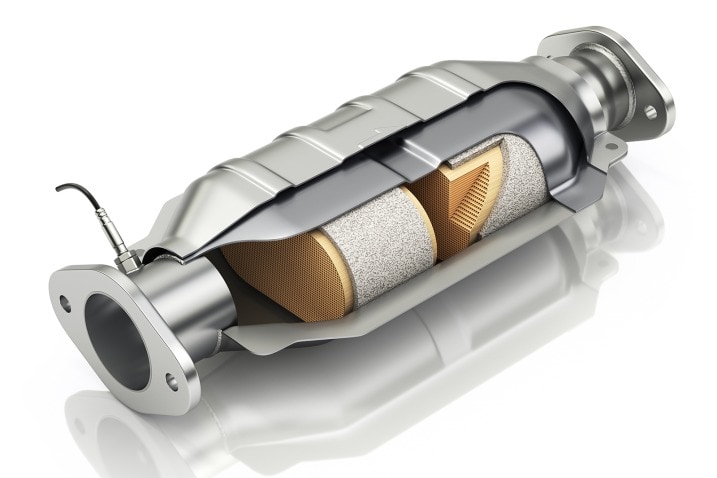What's inside a catalytic converter?
A catalytic converter is made from a heat-resistant substrate and has a large honeycomb set of passageways or ceramic beads coated with a catalyst.
There are two types of catalysts: reduction and oxidation. A reduction catalyst helps reduce nitrogen oxide pollution by separating the molecules into harmless nitrogen and oxygen. An oxidation catalyst changes carbon monoxide into carbon dioxide through an opposite process of adding oxygen. Both catalyst types are made with precious metals, such as platinum, rhodium and palladium. The average catalytic converter contains about 1-2 grams of rhodium, about 3-7 grams of platinum, and between 2 and 7 grams of palladium, with higher quantities of these metals used in vehicles with larger engines. These metals fetch a pretty penny on the black market, which is why the catalytic converter is one of the most stolen parts on a vehicle.
What are the different types of catalytic converters?
There are two primary types of catalytic converters: two-way and three-way. Both were created as a means for auto manufacturers to reduce emissions in accordance with the United States Clean Air Act enacted in 1970.
Introduced first was the two-way (or oxidation) catalytic converter, which oxidizes carbon monoxide — resulting in carbon dioxide — and hydrocarbons — resulting in carbon dioxide and water — by using a substrate coated with platinum and palladium metals. The two-way type only has an oxidation catalyst; therefore, it can't effectively oxidize nitrogen, which contributes to smog and acid rain when released into the atmosphere.
As a result, the two-way converter was phased out of most gasoline engines in America and Canada after 1981 to make way for the three-way converter. It also has an oxidation catalyst and adds a reduction catalyst, which contains rhodium to control the emission of nitric oxide and nitrogen dioxide. Newer gas-powered cars have three-way converters because they're required to meet stricter emission standards.
The type of catalytic converter a vehicle has depends on many variables, including the vehicle's size and age, the type of catalysts used, whether the vehicle is a hybrid, and even where the catalytic converter is located. However, most vehicles today use a three-way converter, unless the vehicle has a diesel engine.
Diesel engines primarily use two-way catalytic converters because they are more effective at converting pollutants into harmful gases. Diesel fuel contains more sulfur than gasoline. Sulfur can impact the chemical reaction performed by a three-way catalytic converter, so a two-way converter is used instead, with diesel exhaust fluid primarily handling the NOx cleanup. This, in turn, makes the three-way converter and its process less efficient at cleaning up diesel exhaust fumes.
However, a two-way converter in a diesel engine is slightly different than in a gas-powered vehicle. This converter uses a diesel oxidation catalyst (DOC) designed specifically for diesel engines and equipment. A DOC is designed to work with the higher temperatures and soot levels of diesel exhaust, but it reduces emissions and some particulate matter in the same fashion. The converter also does not contain rhodium so a diesel particulate filter (DPF) is attached to trap specific matter found only in diesel fuel, while a selective catalyst reduction (SCR) catalyst is attached to reduce nitric oxide and nitrogen dioxide emissions.
Where is a catalytic converter located on a car?
Catalytic converters are placed as close as possible to the engine because they require a temperature of 400 degrees Celsius (752 degrees Fahrenheit) to operate effectively. They are usually located underneath the car in the exhaust between the engine and muffler. The catalytic converter is wider than an exhaust pipe and looks like a muffler.
How much is a catalytic converter?
The cost of replacing a catalytic converter can vary based on several factors, such as the make and model of the vehicle and where you purchase it from. Another variable is the type of catalytic converter required and usually depends on if you need a direct-fit versus a universal-fit converter.
A direct-fit converter is designed to essentially mimic the manufacturer's catalytic converter on your vehicle. It will match the size and shape of the original catalytic converter and will fit easily into the original exhaust system. Direct-fit converters are generally bolted on and do not need any additional modifications. While installation is fairly simple, it can be pricey. A direct-fit replacement can cost anywhere from $300 to $2,500 depending on the vehicle model, not including labor costs.
A universal-fit converter is designed to be just that: universal. This means that it can work in almost any vehicle and is generally preferred when a custom exhaust system is already on the vehicle. The good news is the part only costs around $200-$300. But labor fees should be factored in, as it is harder to install than a direct-fit option. A universal-fit replacement is installed by cutting out the old converter from the exhaust section and welding or clamping in a new one, as well as other exhaust system components, to ensure the right fit.
